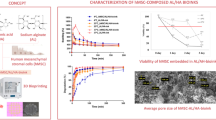Abstract
Osteochondral (OC) tissue is comprised of articular cartilage, the subchondral bone and the central cartilage-bone interface. To facilitate proper regeneration, an equally complex and multiphasic matrix must be used. Although mono-phasic and bi-phasic matrices were previously applied, they failed to establish the OC interface upon regeneration. In this study, we designed and developed a novel matrix with increasing pore volume from one end to other, along the matrix length. For this matrix polylactide-co-glycolide (PLGA) 85:15 microspheres were combined with a water-soluble porogen in a layer-by-layer fashion and thermally sintered. The resulting matrix was then porogen-leached to form a gradiently-porous structured matrix. The formation of this gradient pore structure was established using Micro-Computed Tomography (μCT) scanning. A biodegradable hydrogel was infiltrated into the structure to form a unique OC matrix where the microsphere and hydrogel phases co-exist with opposing gradients. When the individual phases are associated with osteogenic and chondrogenic growth factors, the structureinduced factor delivery might provide the spatially controlled factor delivery necessary to regenerate osteochondral tissue structure. Overall, we designed a gradient matrix system that is expected to support osteochondral tissue engineering while forming a seamless interface between the cartilage and the bone matrix.
Similar content being viewed by others
References
SP Nukavarapu, DL Dorcemus (2013) Osteochondral tissue engineering: Current strategies and challenges. Biotechnology Advances 31: 706–721.
X Shao, J Goh, DW Hutmacher, EH Lee, GE Zigang (2006) Repair of Large Articular Osteochondral Defects Using Hybrid Scaffolds and Bone Marrow-Derived Mesenchymal Stem Cells in a Rabbit Model. Tissue Eng 12.
M Liu, X Yu, F Huang, S Cen, G Zhong, et al. (2013) Tissue Engineering Stratified Scaffolds for Articular Cartilage and Subchondral Bone Defects Repair. Orthopedics 36: 868–873.
N Mohan, NH Dormer, KL Caldwell, VH Key, CJ Berkland, MS Detamore (2011) Continuous gradients of material composition and growth factors for effective regeneration of the osteochondral interface. Tissue Eng Part A 17.
CR Chu, RD Coutts, M Yoshioka, FL Harwood, AZ Monosov, et al. (1995) Articular-Cartilage Repair Using Allogeneic Perichondrocyte-Seeded Biodegradable Porous Polylactic Acid (PLA): A Tissue Engineering Study. Journal of Biomedical Materials Research 29.
JZ Gao, JE Dennis, LA Solchaga, AS Awadallah, VM Goldberg, et al. (2001) Tissueengineered fabrication of an osteochondral composite graft using rat bone marrowderived mesenchymal stem cells. Tissue Engineering 7.
J Malda, TBF Woodfield, F van der Vloodt, C Wilson, DE Martens, et al. (2005) The effect of PEGT/PBT scaffold architecture on the composition of tissue engineered cartilage. Biomaterials 26.
AMJ Getgood, SJ Kew, R Brooks, H Aberman, T Simon, et al. (2012) Evaluation of earlystage osteochondral defect repair using a biphasic scaffold based on a collagenglycosaminoglycan biopolymer in a caprine model. Knee 19.
RM Schek, JM Taboas, SJ Segvich, SJ Hollister, PH Krebsbach (2004) Engineered osteochondral grafts using biphasic composite solid free-form fabricated scaffolds. Tissue Engineering 10.
M Keeney, A Pandit (2009) The Osteochondral Junction and Its Repair via Bi-Phasic Tissue Engineering Scaffolds. Tissue Engineering Part B-Reviews 15.
KA Athanasiou, EM Darling, JC Hu (2009) Articular Cartilage Tissue Engineering; K Athanasiou, editor: Morgan & Claypool. 168 p.
EN Marieb (2001) Human Anatomy & Physiology; K Ueno, editor. San Francisco: Benjamin Cummings.
AR Amini, DJ Adams, CT Laurencin, SP Nukavarapu (2012) Optimally porous and biomechanically compatible scaffolds for large-area bone regeneration. Tissue Eng Part A 18.
J Igwe, PE Mikael, SP Nukavarapu (2014) Design, fabrication and in vitro evaluation of novel polymer-hydrogel hybrid scaffold for bone tissue engineering. J Regen Med Tissue Engin. 2.
Author information
Authors and Affiliations
Rights and permissions
About this article
Cite this article
Dorcemus, D.L., Nukavarapu, S.P. Novel and Unique Matrix Design for Osteochondral Tissue Engineering. MRS Online Proceedings Library 1621, 17–23 (2014). https://doi.org/10.1557/opl.2014.285
Published:
Issue Date:
DOI: https://doi.org/10.1557/opl.2014.285




